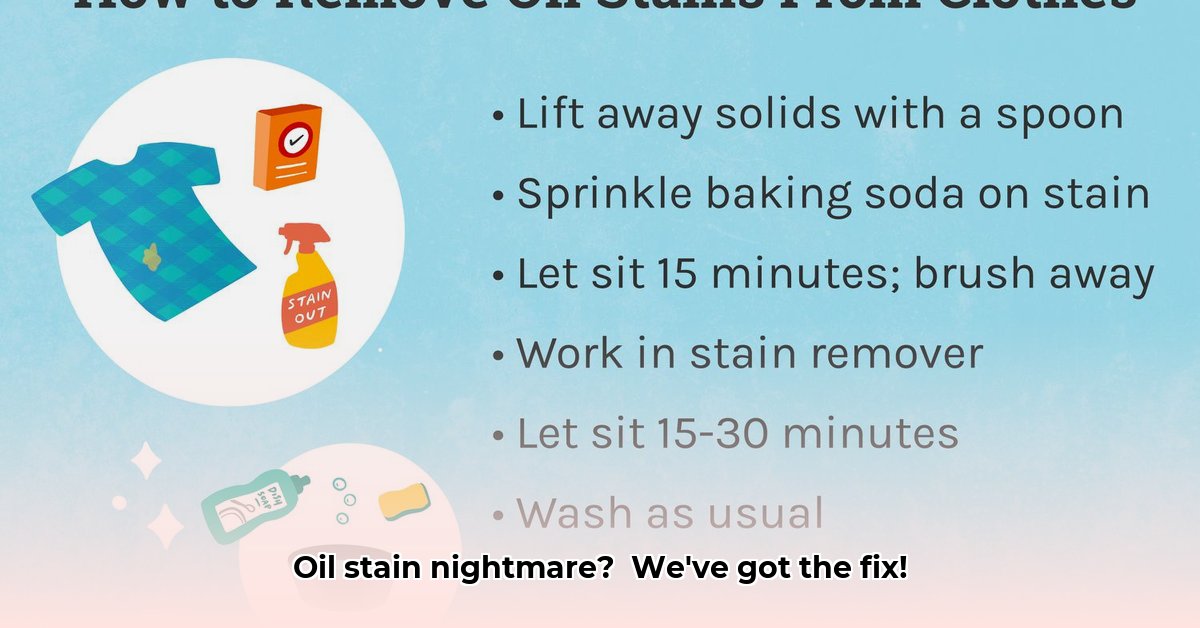Decoding the Stain: Assessing Damage and Gathering Your Arsenal
Discovering motor oil on your clothes can be disheartening, but don’t panic! Whether the stain is fresh or stubbornly set-in, removal is entirely possible with a strategic approach. Begin by carefully examining the stain: is it a recent spill or an older mark? This determines your cleaning strategy. Equally important is identifying the fabric type: delicate materials like silk demand a gentler touch than robust denim. Assembling the necessary supplies beforehand streamlines the entire process.
Essential Cleaning Supplies: Your Stain-Fighting Toolkit
- Oil-Absorbing Agents: Cornstarch, baking soda, or talcum powder act as powerful sponges, drawing out the oil from the fabric.
- Gentle Dish Soap: Choose a mild dish soap for pre-treating the stain without harming the fibers.
- Soft-Bristled Brush (e.g., old toothbrush): This tool gently works the cleaning solution into the stain, maximizing its effectiveness.
- Clean Cloths/Paper Towels: These are essential for blotting and wiping away the lifted oil.
- Laundry Detergent: Your regular laundry detergent completes the cleaning process, removing any remaining residue.
- Optional Solvents (Use with Extreme Caution): Acetone or WD-40 can combat stubborn stains on durable fabrics only. Always test on an inconspicuous area first to avoid damaging the material. These solvents can be powerful allies, but they require careful handling.
Conquering Fresh Motor Oil Stains: A Step-by-Step Guide
Fresh oil spills are easier to tackle if addressed immediately. The key is to blot, never rub, to prevent the stain from spreading and deepening. Blotting is the crucial first step towards successful stain removal.
- Blot Away the Excess: Using a clean cloth or paper towel, gently blot the stain to lift as much oil as possible. Avoid rubbing, which can push the oil deeper into the fibers.
- Deploy the Absorbent Powder: Generously cover the affected area with cornstarch, baking soda, or talcum powder. Allow it to sit for a minimum of 30 minutes, or even longer for maximum oil absorption. This step draws out the oil, preparing the stain for further treatment.
- Dish Soap Treatment: Apply a small amount of mild dish soap directly to the stain. Gently work it into the fabric using your fingers or a soft-bristled brush. This breaks down the oil, making it easier to rinse away.
- Rinse and Repeat (If Necessary): Rinse the area thoroughly with cool water, ensuring all traces of soap and loosened oil are removed. If the stain persists, repeat steps 2-4. Patience is key to achieving optimal results.
- Launder as Usual: Wash the garment according to the care instructions on its label. Crucially, inspect the stain before placing the garment in the dryer. Heat sets any remaining oil, making it nearly impossible to remove later.
Tackling Set-In Motor Oil Stains: A Guide for Stubborn Marks
Older, set-in stains present a greater challenge, but they are not invincible. With a little persistence and the right techniques, you can restore your garment. Leaving the absorbent powder on overnight significantly boosts its effectiveness. Common household items, when used strategically, can conquer even the toughest stains.
- Overnight Absorbent Powder Treatment: Repeat the absorbent powder step from the fresh stain removal process, but this time, leave the powder on the stain overnight. This extended contact time allows for deep penetration and maximum oil absorption.
- Solvent Application (Exercise Extreme Caution): For particularly stubborn stains on durable fabrics only, consider using acetone or WD-40. Always perform a spot test on a hidden area first. If safe, apply a small amount of solvent to the stain, gently work it in, and let it sit for a few minutes before rinsing thoroughly. These solvents can be effective, but they must be used responsibly.
- Persistence Pays Off: Repeat steps 2-3 as necessary until the stain fades significantly. Multiple applications may be required for complete removal.
- The Final Wash: Launder the garment as usual, following the care instructions on the label. Before drying, meticulously check the stain to ensure it has vanished completely.
Fabric-Specific Care and Troubleshooting: Tailoring Your Approach
Different fabrics respond differently to cleaning agents. Delicate materials, such as silk or wool, require extra care and attention. Always consult the garment’s care label before attempting any stain removal method. For delicate or valuable items, professional dry cleaning might be the safest course of action. Choosing the appropriate cleaning method based on fabric type prevents damage and maximizes stain removal effectiveness.
Troubleshooting Tips: Addressing Lingering Issues
- The Stubborn Stain: If the stain refuses to budge despite multiple attempts, professional dry cleaning is recommended. Expert stain removal techniques may be necessary.
- Lingering Oil Odor: Neutralize any persistent oil smell by adding a cup of white vinegar to your washing machine along with your detergent during the final wash. Vinegar acts as a natural deodorizer, leaving your clothes fresh and clean.
By following these detailed steps and tailoring your approach to the specific stain and fabric type, you can successfully remove motor oil stains, saving your clothes from the discard pile. Patience and a methodical approach are your greatest allies in this stain-fighting endeavor. Remember, even the most stubborn stains can be overcome with the right techniques and a little persistence!
- Get Safest Sims 4 Mods From These Trusted Sources - December 1, 2025
- Sims 4 Mods For Better Gameplay Boost Realism And Customization - November 30, 2025
- Sims 4 Base Game Mods For Essential Gameplay Improvements - November 29, 2025










